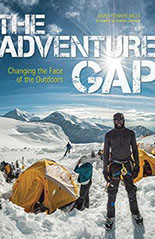James Edward Mills, Mountaineers Books, 256 pages 2014. Paperback.
Review by Susan Weida
As our country grows to be increasingly multi-cultural, it is vital that people of diverse racial and cultural groups develop a passion and love for the outdoors in order to protect and advocate for preservation of our wild places.
The Adventure Gap provides an excellent introduction into what is needed to make this a reality. It does this by centering on a compelling story about the first all African-American summit expedition on Denali, Alaska in 2013. Once you engage in the story of these climbers and their personal stories you will find it hard to stop reading.
The author, James Mills, makes a case for the vital role of men- tors to introduce young people of color to the outdoors and help them see themselves as part of this world. The world of outdoor adventure, especially in high skill, high risk areas such as mountain climbing has been represented in the media as a white male’s domain.
Often the history of people of color who did lead in the outdoors has been ignored and forgotten. While taking you step by step with the team through their preparation and climb of Denali, Mills interweaves the background stories of the team members. Although team members have accomplished significant success in both professional areas and in their avocation of climbing, most have faced a variety of life challenges.
Mills draws the line between how an outdoor mentor made a difference in their lives and how they are committing themselves to mentoring the next generation to connect with the outdoors.
Mills also weaves into his narrative some of the historical role models for the team- the role of the Buffalo Sol- diers in the early days of our National Park system, Charles Crenchaw who was the first African American to summit Denali, and Matthew Henson who reached the North Pole with Admiral Robert Peary. He also tells a touching story about middle school climbing champion Kai Lightner who in turn was being inspired by Expedition Denali.
There were two other additional points of interest for me in this book. One was the story of the author who had a passion to be part of Expedition Denali but was unable to make the ‘cut’ due to physical limitations. Mills went on to be a huge part of the accomplishments of the group by writing their story. The second is the acknowledgment that Mills gives to Aparna Rajagopal-Durbin, at that time the Diversity and Inclusion Manager for NOLS (National Outdoor Leadership School), for conceiving Expedition Denali. Aparna is part of the consulting team who is guiding the AMC Diversity, Equity, and Inclusion plan, and I had the opportunity to participate in training with her in 2017.
I would recommend this book as a way to educate yourself about the value of diversity in the outdoors while enjoying an exciting tale of adventure and achievement.

